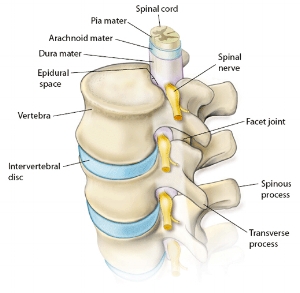Degenerative Disc Disease: What Exactly Is Degenerating?
If you suffer from neck pain, low back pain, or odd sensations in your arms and legs, you may be told that you’re suffering from degenerative disc disease. But what does that diagnosis really mean — what’s actually going in your spinal column, and what can do you to get relief from your symptoms? Let’s take a closer look at this confusing, distressing condition and your options for restoring function and comfort to your life.
Changes in Your Spine: The Cause of Back Pain
One of the most confusing aspects of degenerative disc disease is that the fact it really isn’t a “disease.” Rather, it’s a set of symptoms related to multiple physical changes in your spine. The spinal column includes a lot of working parts, including vertebrae, joints, discs, and of course the spinal cord and nerves at the center of it all. Any change that affects one of these components can cause a “domino effect” of changes.
Bulging and Herniated Discs
The spinal discs themselves may be the starting point of the degenerative process. A disc normally gets its height and cushioning ability from its fluid interior. As a disc ages, however, it can start to lose water content. This loss of water causes the disc to shrink, flatten and bulge out of the spinal column. You may also be familiar with the term bulging disc, caused by the loss of fluid in the discs.

The reduced amount of space between discs irritates the facet joints, a problem that can lead to spinal arthritis. Additionally, discs feeling the squeeze from excess or unbalanced weight can herniate. This is where the term herniated disc comes from, but really it’s a reference to degenerative disc disease. Herniated disc occurs when the core inside the disc pushes out of a tear in the casing or annulus, becomes inflamed, and pinches or compresses the nerve root(s) located nearby.
Spinal Stenosis
Spinal stenosis and spondylolisthesis are two other uncomfortable issues associated with degenerative disc disease. Stenosis may occur when arthritis causes bone spurs that narrow the spinal canal. In spondylolisthesis, changes in the facet joints allow one vertebra to shift forward or backward over the adjacent vertebra located below.
Try Conservative Neck and Back Care First
The first course of treatment for this type of neck pain and back pain caused by degenerative disc disease is not typically surgery. Other treatment options are typically tried first, including:
- Anti-inflammatory medications. You might start with over the counter medicines like Naproxen or ibuprofen that may be able to reduce your immediate symptoms while you rest and avoid lifting anything heavy. If OTC medications aren’t working, talk to your back specialist about what may be a better alternative.
- Exercises that can strengthen the major muscle groups that support your spine and make you more flexible.
- Lifestyle changes which include: giving up smoking to improve blood circulation and losing extra weight.
While degenerative disc disease can be a painful and annoying issue, take action to avoid your quality of life degenerating as well. Take care of yourself, and give your neck or back time to heal.
Read more about Degenerative Disc Disease and Dr. Fayaz’s typical approach to neck pain and back pain treatment for patients in The Woodlands and the surrounding areas. Call our office for an appointment if you’re ready to speak to a spine specialist about treatment options.
